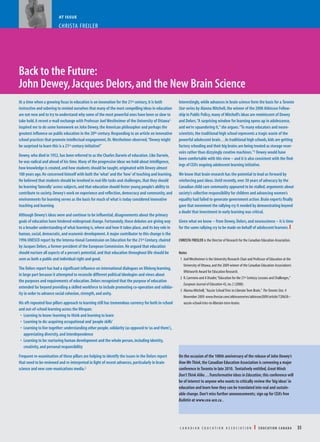
EdCan-2010-v50-n1-Freiler-At-Issue_1
- 1. AT ISSUE CHRISTA FREILER Back to the Future: John Dewey,Jacques Delors,and the New Brain Science At a time when a growing focus in education is on innovation for the 21st century,it is both instructive and sobering to remind ourselves that many of the most compelling ideas in education are not new and to try to understand why some of the most powerful ones have been so slow to take hold.A recent e-mail exchange with Professor Joel Westheimer of the University of Ottawa1 inspired me to do some homework on John Dewey,the American philosopher and perhaps the greatest influence on public education in the 20th century.Responding to an article on innovative school practices that promote intellectual engagement,Dr.Westheimer observed,“Dewey might be surprised to learn this is a 21st century initiative!” Dewey,who died in 1952,has been referred to as the Charles Darwin of education.Like Darwin, he was radical and ahead of his time.Many of the progressive ideas we hold about intelligence, how knowledge is created,and how students should be taught,originated with Dewey almost 100 years ago.He concerned himself with both the‘what’and the‘how’of teaching and learning. He believed that students should be involved in real-life tasks and challenges,that they should be learning‘laterally’across subjects,and that education should foster young people’s ability to contribute to society.Dewey’s work on experience and reflection,democracy and community,and environments for learning serves as the basis for much of what is today considered innovative teaching and learning. Although Dewey’s ideas were and continue to be influential,disagreements about the primary goals of education have hindered widespread change.Fortunately,these debates are giving way to a broader understanding of what learning is,where and how it takes place,and its key role in human,social,democratic,and economic development.A major contributor to this change is the 1996 UNESCO report by the Interna-tional Commission on Education for the 21st Century,chaired by Jacques Delors,a former president of the European Commission.He argued that education should nurture all aspects of a person’s potential,and that education throughout life should be seen as both a public and individual right and good. The Delors report has had a significant influence on international dialogues on lifelong learning, in large part because it attempted to reconcile different political ideologies and views about the purposes and requirements of education.Delors recognized that the purpose of education extended far beyond providing a skilled workforce to include promoting co-operation and solidar- ity in order to advance social cohesion,strength,and unity. His oft-repeated four pillars approach to learning still has tremendous currency for both in-school and out-of-school learning across the lifespan: • Learning to know:learning to think and learning to learn • Learning to do:acquiring occupational and‘people skills’ • Learning to live together:understanding other people,solidarity (as opposed to‘us and them’), appreciating diversity,and interdependence • Learning to be:nurturing human development and the whole person,including identity, creativity,and personal responsibility Frequent re-examination of these pillars are helping to identify the issues in the Delors report that need to be reviewed and re-interpreted in light of recent advances,particularly in brain science and new com-munications media.2 Interestingly,while advances in brain science form the basis for a Toronto Star series by Alanna Mitchell,the winner of the 2008 Atkinson Fellow- ship in Public Policy,many of Mitchell’s ideas are reminiscent of Dewey and Delors.“A surprising window for learning opens up in adolescence, and we’re squandering it,”she argues.“To many educators and neuro- scientists,the traditional high school represents a tragic waste of the powerful adolescent brain…In traditional high schools,kids are getting factory schooling and their big brains are being treated as storage reser- voirs rather than dizzyingly creative machines.”3 Dewey would have been comfortable with this view – and it is also consistent with the find- ings of CEA’s ongoing adolescent learning initiative. We know that brain research has the potential to lead us forward by reinforcing past ideas.Until recently,over 30 years of advocacy by the Canadian child care community appeared to be stalled;arguments about society’s collective responsibility for children and advancing women’s equality had failed to generate government action.Brain experts finally gave that movement the rallying cry it needed by demonstrating beyond a doubt that investment in early learning was critical. Given what we know – from Dewey,Delors,and neuroscience – it is time for the same rallying cry to be made on behalf of adolescent learners.I CHRISTA FREILER is the Director of Research for the Canadian Education Association. Notes 1 JoelWestheimer is the University Research Chair and Professor of Education at the University of Ottawa,and the 2009 winner of the Canadian Education Association’s Whitworth Award for Education Research. 2 R.Carrneiro and A Draxler,“Education for the 21st Century:Lessons and Challenges,” European Journal of Education 43,no.2 (2008). 3 Alanna Mitchell,"Aussie SchoolTries to LiberateTeen Brain," TheToronto Star,4 November 2009.www.thestar.com/atkinsonseries/atkinson2009/article/720658-- aussie-school-tries-to-liberate-teen-brains On the occasion of the 100th anniversary of the release of John Dewey’s HowWeThink,the Canadian Education Association is convening a major conference in Toronto in late 2010. Tentatively entitled,Great Minds Don’tThink Alike…Transformative Ideas in Education,this conference will be of interest to anyone who wants to critically review the‘big ideas’in education and learn how they can be translated into real and sustain- able change.Don’t miss further announcements; sign up for CEA’s free Bulletin at www.cea-ace.ca . C A N A D I A N E D U C A T I O N A S S O C I A T I O N I E D U C AT I O N C A N A D A 35 You are free to reproduce, distribute and transmit this article, provided you attribute the author(s), Education Canada Vol. 50 (1), and a link to the Canadian Education Association (www.cea-ace.ca) 2010. You may not use this work for commercial purposes. You may not alter, transform, or build upon this work. Publication ISSN 0013-1253.